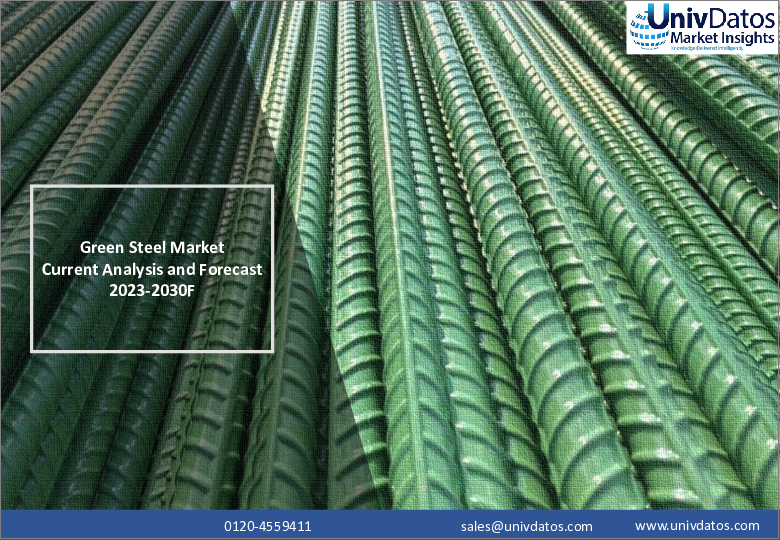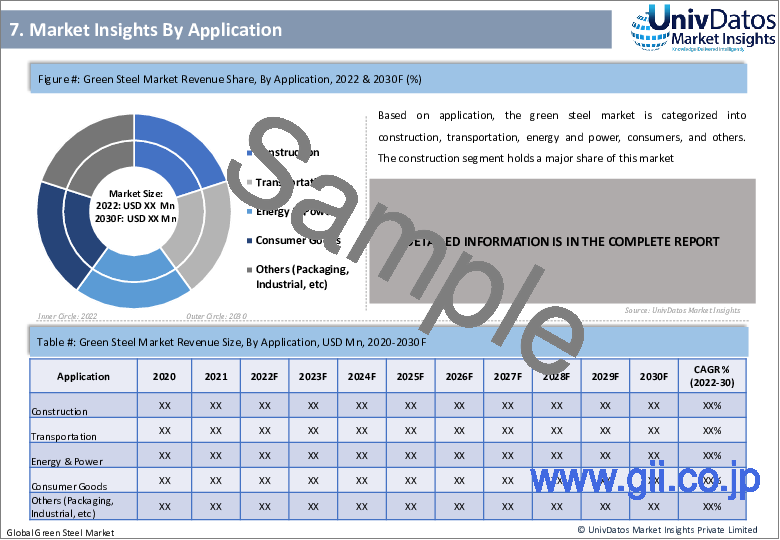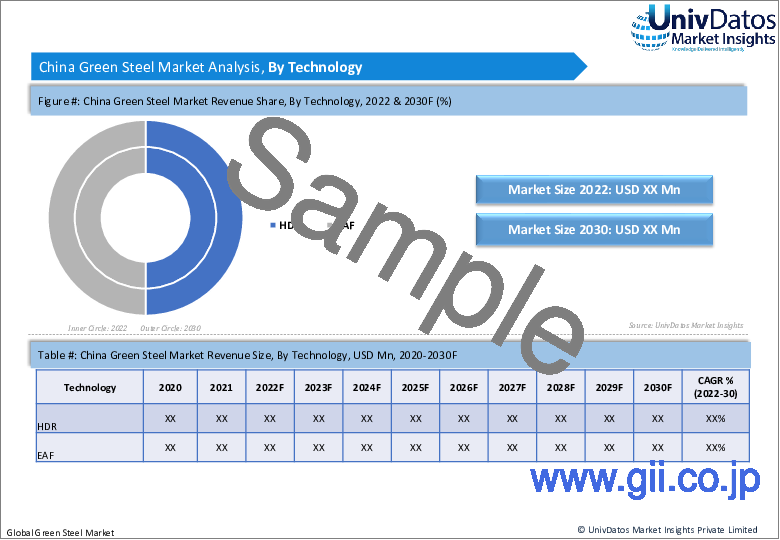|
|
市場調査レポート
商品コード
1408709
グリーンスチール市場:現状分析と予測(2023-2030年)Green Steel Market: Current Analysis and Forecast (2023-2030) |
||||||
カスタマイズ可能
|
|||||||
| グリーンスチール市場:現状分析と予測(2023-2030年) |
|
出版日: 2023年12月30日
発行: UnivDatos Market Insights Pvt Ltd
ページ情報: 英文 152 Pages
納期: 即日から翌営業日
|
- 全表示
- 概要
- 目次
グリーンスチールは、持続可能な鋼または低炭素鋼としても知られ、環境への影響を最小限に抑え、炭素排出量を削減するプロセスを使用して鉄鋼を生産することを指します。 各国や業界が気候変動に対処し、持続可能性の目標を達成しようとする中、グリーンスチールの需要は世界的に増加しています。
従来、鉄鋼は世界中で広く使用されている素材ですが、その生産は人類が全世界で排出するCO2の約8%を占めています。このため、気候変動への対応に対する危機感が高まっており、鉄鋼業界全体が脱炭素化に向けた取り組みを進めています。アルセロール・ミッタル、タタ・スチール、スカニア、金融グループなど、鉄鋼業界の主要企業は、この目標に向けてコミットメントを行っています。
欧州では、化石燃料をグリーンな水素に置き換えることを目的とした、ハイブリットやH2 グリーンスチールのような取り組みがすでに進行中です。一方、マサチューセッツ工科大学(MIT)から生まれたボストン・メタル社は、アルミニウムに使われるプロセスと同様に、鉄鉱石から直接電解するプロセスを開発しています。これらの方法はいずれも再生可能資源からの電力を使用するため、持続可能性が保証され、プロセス中の排出はゼロです。
技術に基づき、グリーンスチール市場はHDR(鉄鉱石の水素ベース直接還元)とEAF(電気アーク炉)に二分されます。HDRセグメントは2022年に大きな需要に対応します。水素直接還元(H-DR)技術は、鉄鋼業における炭素排出を削減する有望な方法です。従来の天然ガスとは異なり、このプロセスでは100%グリーンH2を使用します。H-DR技術を適用することで、長期的には炭素排出の80~90%を回避することが可能です。したがって、この技術が広く適用されることは、鉄鋼業界がよりクリーンな生産へと移行するための画期的な出来事となることが期待されます。
グリーンスチール市場は用途別に、建設、輸送、エネルギー・電力、消費者、その他に分類されます。この市場では、建設分野が大きなシェアを占めています。二酸化炭素排出量を削減するため、グリーンスチールの需要は建設分野で増加しています。鉄鋼の52%は建設セクターで使用されているため、脱炭素化の必要性が高まり、グリーンスチール採用の必要性が高まっています。
グリーンスチール業界の市場導入に関する理解を深めるため、市場は北米(米国、カナダ、その他北米地域)、欧州(ドイツ、英国、フランス、ノルウェー、その他欧州地域)、アジア太平洋(中国、オーストラリア、その他アジア太平洋地域)、世界のその他の地域における世界の存在に基づいて分析されています。グリーンスチール市場は、アジア太平洋地域で大きな成長が見込まれています。アジア太平洋地域の多くの国が、環境に優しい鉄鋼生産を促進するための政策やイニシアチブを実施しているからです。例えば、中国は炭素排出量を削減し、リサイクル鋼の使用量を増やす目標を設定しており、日本はカーボンニュートラルな鉄鋼製造を推進するイニシアティブを打ち出しています。アジア太平洋地域は、太陽光発電や風力発電のような再生可能エネルギーを豊富に利用できるため、製鉄所の電力を賄い、二酸化炭素排出量を削減することができます。さらに、多くの投資家や鉄鋼メーカーが持続可能な鉄鋼生産の可能性を認識し、市場への参入に努めています。投資の増加は、業界のさらなる成長と技術的進歩を促進すると予想されます。
目次
第1章 市場イントロダクション
- 市場の定義
- 主な目標
- ステークホルダー
- 制限事項
第2章 調査手法または前提条件
- 調査プロセス
- 調査手法
- 回答者プロファイル
第3章 市場要約
第4章 エグゼクティブサマリー
第5章 グリーンスチール市場収益、2020-2030年
第6章 技術別の市場洞察
- HDR(鉄鉱石の水素による直接還元)
- EAF(電気アーク炉)
第7章 用途別の市場洞察
- 建設
- 輸送機関
- エネルギーと電力
- 消費財
- その他(包装、工業など)
第8章 地域別の市場洞察
- 北米
- 米国
- カナダ
- その他北米地域
- 欧州
- ドイツ
- 英国
- フランス
- スウェーデン
- その他欧州地域
- アジア太平洋
- 中国
- 日本
- インド
- その他アジア太平洋地域
- 世界のその他の地域
第9章 グリーンスチール市場力学
- 市場促進要因
- 市場の課題
- 影響分析
第10章 グリーンスチール市場機会
第11章 グリーンスチール市場動向
第12章 需要側と供給側の分析
- 需要側分析
- 供給側分析
第13章 政策と規制の枠組み
第14章 バリューチェーン分析
第15章 競合シナリオ
- 競合情勢
- ポーターのファイブフォース分析
第16章 企業プロファイル
- Tata Steel
- Arcelor Mittal
- Salzgitter
- Thyssenkrupp
- H2 Green Steel
- Deutsche Edelstahlwerke Services
- Jindal Steel and Power
- United States Steel Corp
- Tenaris
- Hydnum Steel
第17章 免責事項
Green steel, also known as sustainable or low-carbon steel, refers to the production of steel using processes that have minimal environmental impact and reduce carbon emissions. The demand for green steel has been on the rise globally as countries and industries strive to address climate change and achieve sustainability goals.
Traditionally, steel is a widely used material all over the world, but its production contributes about 8% of the CO2 emissions that humans generate globally. This has led to a growing sense of urgency to address climate change, prompting the entire steel industry to take steps toward decarbonization. Key players in the industry such as ArcelorMittal, Tata Steel, Scania, and financial groups are making commitments towards this goal.
In Europe, initiatives like Hybrit and H2 Green steel are already underway, aimed at replacing fossil fuels with green hydrogen. Meanwhile, Boston Metal, a company that emerged from MIT, is developing a process that uses direct electrolysis from iron ore, like the process used for aluminum. Both these methods use electricity from renewable sources, ensuring sustainability and zero emissions during the process.
Based on the technology, the green steel market is bifurcated into HDR (Hydrogen-Based Direct Reduction of Iron Ore), and EAF (Electric Arc Furnace). The HDR segment caters to significant demand in 2022. Hydrogen direct reduction (H-DR) technology is a promising way to reduce carbon emissions in the steel industry. Unlike conventional natural gas, it uses 100% green H2 in the process. By applying H-DR technology, it is possible to avoid 80-90% of carbon emissions in the long term. Therefore, the widespread application of this technology is expected to be a milestone in the transition of the steel industry towards cleaner production.
Based on application, the green steel market is categorized into construction, transportation, energy and power, consumers, and others. The construction segment holds a major share of this market. To reduce carbon emissions the demand for green steel is propelling in the construction sector. As 52% of steel is used in the construction sector which raises the need to decarbonize it which is accentuating the need for green steel adoption.
For a better understanding of the market adoption of the green steel industry, the market is analyzed based on its worldwide presence in countries such as North America (U.S., Canada, and the Rest of North America), Europe (Germany, U.K., France, Norway, Rest of Europe), Asia-Pacific (China, Australia, Rest of Asia-Pacific), Rest of World. The green steel market is expected to have significant growth in the Asia Pacific region, as many countries in the area have implemented policies and initiatives to promote eco-friendly steel production. For instance, China has set targets to reduce carbon emissions and increase the usage of recycled steel, while Japan has launched initiatives to advance carbon-neutral steel manufacturing. Asia Pacific has access to abundant renewable energy sources like solar and wind power, which can power steel plants and decrease carbon footprints. Additionally, many investors and steel manufacturers are recognizing the potential of sustainable steel production and making efforts to enter the market. The increased investment is expected to drive further growth and technological advancements in the industry.
Some of the major players operating in the market include: Tata Steel, Arcelor Mittal, Salzgitter, Thyssenkrupp, H2 Green Steel, Deutsche Edelstahlwerke Services, Jindal Steel and Power, United States Steel Corp, Tenaris
Hydnum Steel.
TABLE OF CONTENTS
1 MARKET INTRODUCTION
- 1.1. Market Definitions
- 1.2. Main Objective
- 1.3. Stakeholders
- 1.4. Limitation
2 RESEARCH METHODOLOGY OR ASSUMPTION
- 2.1. Research Process of the Green Steel Market
- 2.2. Research Methodology of the Green Steel Market
- 2.3. Respondent Profile
3 MARKET SYNOPSIS
4 EXECUTIVE SUMMARY
5 GREEN STEEL MARKET REVENUE (USD BN), 2020-2030F
6 MARKET INSIGHTS BY TECHNOLOGY
- 6.1. HDR (Hydrogen-Based Direct Reduction of Iron Ore)
- 6.2. EAF (Electric Arc Furnace)
7 MARKET INSIGHTS BY APPLICATION
- 7.1. Construction
- 7.2. Transportation
- 7.3. Energy & Power
- 7.4. Consumer Goods
- 7.5. Others (Packaging, Industrial, etc)
8 MARKET INSIGHTS BY REGION
- 8.1. North America
- 8.1.1. U.S.
- 8.1.2. Canada
- 8.1.3. Rest of North America
- 8.2. Europe
- 8.2.1. Germany
- 8.2.2. U.K.
- 8.2.3. France
- 8.2.4. Sweden
- 8.2.6. Rest of Europe
- 8.3. Asia-Pacific
- 8.3.1. China
- 8.3.2. Japan
- 8.3.3. India
- 8.3.4. Rest of Asia-Pacific
- 8.4. Rest of World
9 GREEN STEEL MARKET DYNAMICS
- 9.1. Market Drivers
- 9.2. Market Challenges
- 9.3. Impact Analysis
10 GREEN STEEL MARKET OPPORTUNITIES
11 GREEN STEEL MARKET TRENDS
12 DEMAND AND SUPPLY-SIDE ANALYSIS
- 12.1. Demand Side Analysis
- 12.2. Supply Side Analysis
13 POLICY AND REGULATORY FRAMEWORK
14 VALUE CHAIN ANALYSIS
15 COMPETITIVE SCENARIO
- 15.1. Competitive Landscape
- 15.1.1. Porters Fiver Forces Analysis
16 COMPANY PROFILED
- 16.1. Tata Steel
- 16.2. Arcelor Mittal
- 16.3. Salzgitter
- 16.4. Thyssenkrupp
- 16.5. H2 Green Steel
- 16.6. Deutsche Edelstahlwerke Services
- 16.7. Jindal Steel and Power
- 16.8. United States Steel Corp
- 16.9. Tenaris
- 16.10. Hydnum Steel






